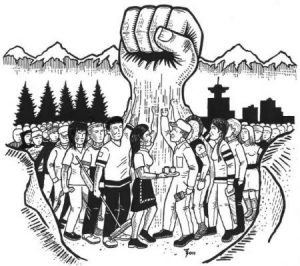(Reading Time: 5 minutes)
Who can say when it started to change, or was the employer/employee relationship never a balanced one?
Some would argue that the relationship was historically slanted in favour of the employer only to be disrupted by the rise of labour unions in the early 20th century and then further disrupted by increasingly interventionist labour-oriented laws and regulations. This power shift in favour of labour perhaps peaked in the 70’s and 80’s but was then gradually offset by globalization, with the offshoring of many jobs, technological change, the rise of app-driven gig  work and the increasing prevalence of contract work in place of direct employment relationships. The supply and demand disruptions that these forces have imposed on the employment marketplace continue with the recent pandemic-related closure of large sectors of the economy and the availability of government financial support which has tended to make employment opportunities at or near minimum wage to appear relatively unattractive vs. the government support available. If government support equates to $12.00 per hour and the minimum wage is $15.00 per hour, any rational person would see that, in the short run at least, the differential income difference for getting out of bed, commuting and actually working is a paltry $3.00 per hour. Why would anyone do that, except those with a longer term (and probably wiser) view that government support will not last forever and that there is a long-term benefit in learning new skills on the job, gaining experience, making contacts and building a career?
work and the increasing prevalence of contract work in place of direct employment relationships. The supply and demand disruptions that these forces have imposed on the employment marketplace continue with the recent pandemic-related closure of large sectors of the economy and the availability of government financial support which has tended to make employment opportunities at or near minimum wage to appear relatively unattractive vs. the government support available. If government support equates to $12.00 per hour and the minimum wage is $15.00 per hour, any rational person would see that, in the short run at least, the differential income difference for getting out of bed, commuting and actually working is a paltry $3.00 per hour. Why would anyone do that, except those with a longer term (and probably wiser) view that government support will not last forever and that there is a long-term benefit in learning new skills on the job, gaining experience, making contacts and building a career?
Each action in favour of one side or the other of the employer/employee relationship has invited an eventual counter-response in the opposite direction. The rise of labour unions and much enhanced working conditions and financial rewards in developed countries eventually brought about both the offshoring of employment and, more importantly, the rise of capital investments in productivity tools and technological change which have eliminated many unskilled and semi-skilled positions.  Offshoring brought about rising wages in the destination countries and made them relatively less attractive given the negatives that often accompanied the offshoring bargain – sometimes lower quality, difficult supervision, long lead times and large minimum order quantities. Over time, offshoring has been dynamic, moving fluidly from destinations where costs have risen or where political and legal risks have increased to destinations where these factors are such that the bargain is still worth it.
Offshoring brought about rising wages in the destination countries and made them relatively less attractive given the negatives that often accompanied the offshoring bargain – sometimes lower quality, difficult supervision, long lead times and large minimum order quantities. Over time, offshoring has been dynamic, moving fluidly from destinations where costs have risen or where political and legal risks have increased to destinations where these factors are such that the bargain is still worth it.
As the negatives of offshoring have increased (including tax changes in the U.S. which has also made offshoring less attractive), there has been some return to domestic manufacturing (onshoring). In any case, globalization and offshoring were never the main drivers of the decline of domestic employment. Technological change and capital investment always were.
The pandemic of 2020 – 2021 (2022 +?) has introduced a number of survival responses that will likely continue in place for some time (or in perpetuity). The “work from home” (WFH) phenomena has become mainstream and while many workers who were able to WFH because of the nature of their jobs will likely return to the office most of the time, there will likely now be much greater comfort on the part of both employers and employees to have the WFH option continue on a partial if not full-time basis in many cases. This has caused a number of changes to the  employer/employee relationship which are not all one-sided. Some employees who are able to WFH on a full-time basis have taken the opportunity to change their lifestyle and perhaps relocate to a more distant and lower cost area. This works well for those who have duties that are largely independent and do not require a lot of in-person collaboration and for those who are not upwardly mobile within their organization. For others, being at the work location for at least part of the time may be a requirement from the employer and may be a necessity for anyone who aspires to advance in the organization. It is more difficult to be noticed and considered to be a “player” if not present, physically, at the work location on a regular basis. For such individuals, full-time WFH will work against their interests.
employer/employee relationship which are not all one-sided. Some employees who are able to WFH on a full-time basis have taken the opportunity to change their lifestyle and perhaps relocate to a more distant and lower cost area. This works well for those who have duties that are largely independent and do not require a lot of in-person collaboration and for those who are not upwardly mobile within their organization. For others, being at the work location for at least part of the time may be a requirement from the employer and may be a necessity for anyone who aspires to advance in the organization. It is more difficult to be noticed and considered to be a “player” if not present, physically, at the work location on a regular basis. For such individuals, full-time WFH will work against their interests.
Another aspect, which is beginning to appear, is that remote WFH employees are competing with other WFH candidates for their jobs. Employers have reasoned that if a role can successfully be performed by someone on a WFH basis then it is not necessary to pay big city wages to attract someone local to the work location to do it. Employees who have benefited by removing themselves and taking their “big city” wages to a more remote location to benefit from the difference in living costs are now facing the problem of competition from other remote workers.
 As government support subsides, more people who took the short-term view of “why should I work for $3.00 per hour” will be forced to rejoin the work force and the labour supply shortage at the lower end of the market will be resolved.
As government support subsides, more people who took the short-term view of “why should I work for $3.00 per hour” will be forced to rejoin the work force and the labour supply shortage at the lower end of the market will be resolved.
Outside of government many organizations have maintained their non-union status by providing employees with an attractive relationship that doesn’t require third party (union) intervention. Some have made use of contract or gig relationships to avoid largely or completely employee relationships. Staffing companies that take on the employer/employee relationship and provide contract workers to companies, benefit from this trend and countries with the most onerous employee-oriented legislation have the most active staffing companies providing contract workers.
Read More – 2023 (After the Crisis)
Other companies have responded to unionized labour by forming their own “unions” in the form of industry associations where large numbers of companies present a common front to a union representing a particular trade to negotiate contractual terms on behalf of all of the employers who are members of the association. This is often beneficial for both sides and can be said to be a case where there is a balance of power.
 Governments on the other hand, continue to be dominated by the unions representing government employees as they do not have real world competitive forces that provide a “red line” beyond which they cannot go or else risk ceasing to exist. It is far too easy for governments to accede to union pressure across the board and pass along the cost of these decisions to taxpayers, most of whom are the subject of real-world pressures either as employees or as employers.
Governments on the other hand, continue to be dominated by the unions representing government employees as they do not have real world competitive forces that provide a “red line” beyond which they cannot go or else risk ceasing to exist. It is far too easy for governments to accede to union pressure across the board and pass along the cost of these decisions to taxpayers, most of whom are the subject of real-world pressures either as employees or as employers.
Kathbern Management is an executive search firm based in Toronto, helping companies find the executives and senior managers who not only have the experience and credentials to fulfill their responsibilities, but also have the emotional and “fit” requirements that will enable them to be successful in a particular environment. We simplify the process and, through our deep research, are able to bring more and better candidates forward than would ever be possible through a do-it-yourself passive advertising campaign.
Contact us today for a free consultation about your key person search.

